Leadership and Learning Organization: 21st Century Perspectives
VerifiedAdded on 2022/12/26
|7
|1962
|72
Essay
AI Summary
This essay provides a comprehensive overview of leadership and learning organizations. It begins with a definition and rationale for learning organizations, then delves into key principles and practices. The essay explores three classical theories: experimental learning, generative and adaptive learning, and assimilation theory, comparing and contrasting organizational learning models. It further examines the leadership of the 21st century, highlighting essential competencies and attributes, and analyzes contemporary leadership trends, including the impact of business growth, workforce diversity, and technological advancements. The essay discusses various leadership perspectives, such as shared leadership and leadership for the community, and offers practical applications, using W.L. Gore and Apple Incorporation as examples. The essay concludes by emphasizing the importance of relationships in modern leadership.
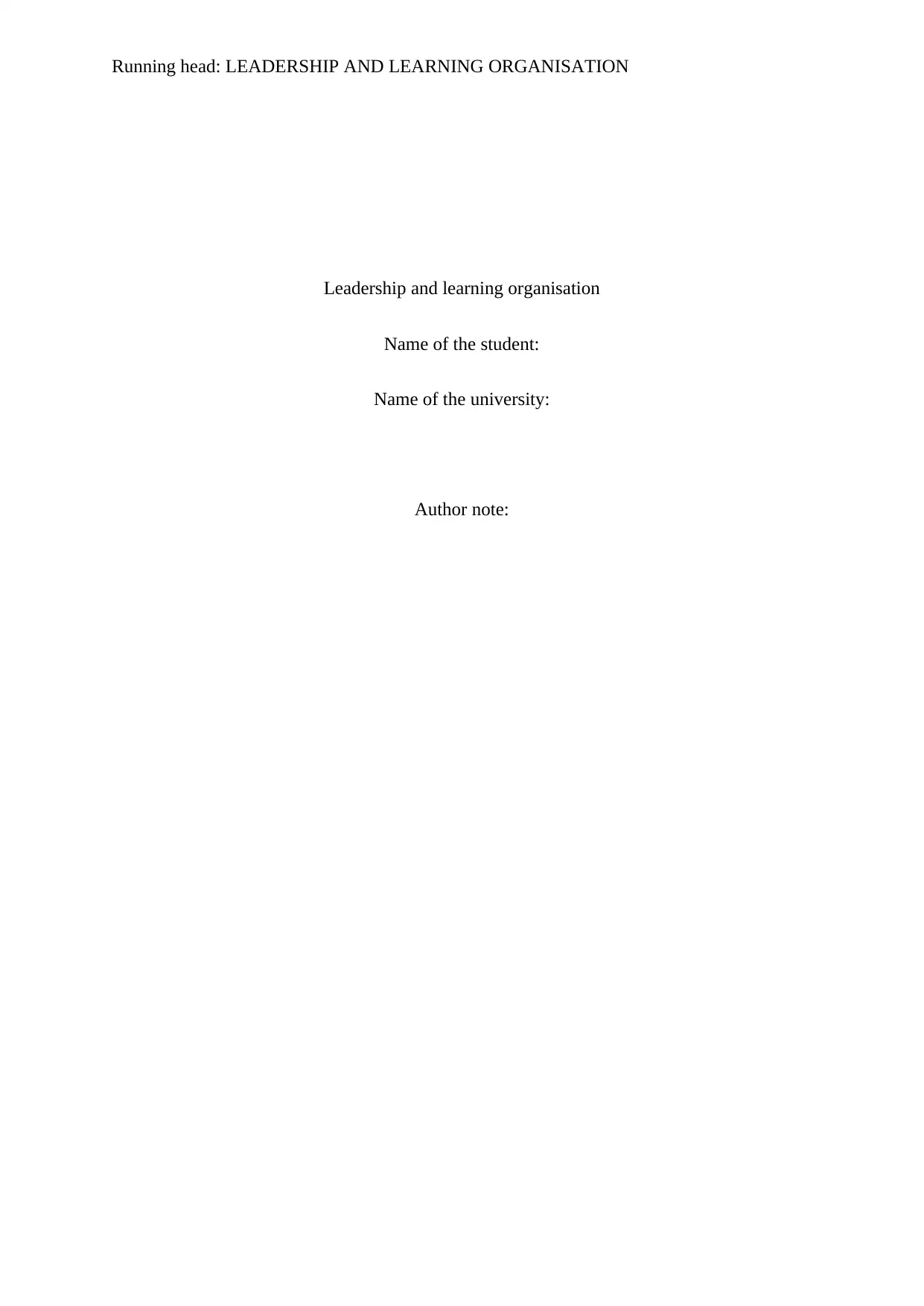
Running head: LEADERSHIP AND LEARNING ORGANISATION
Leadership and learning organisation
Name of the student:
Name of the university:
Author note:
Leadership and learning organisation
Name of the student:
Name of the university:
Author note:
Paraphrase This Document
Need a fresh take? Get an instant paraphrase of this document with our AI Paraphraser
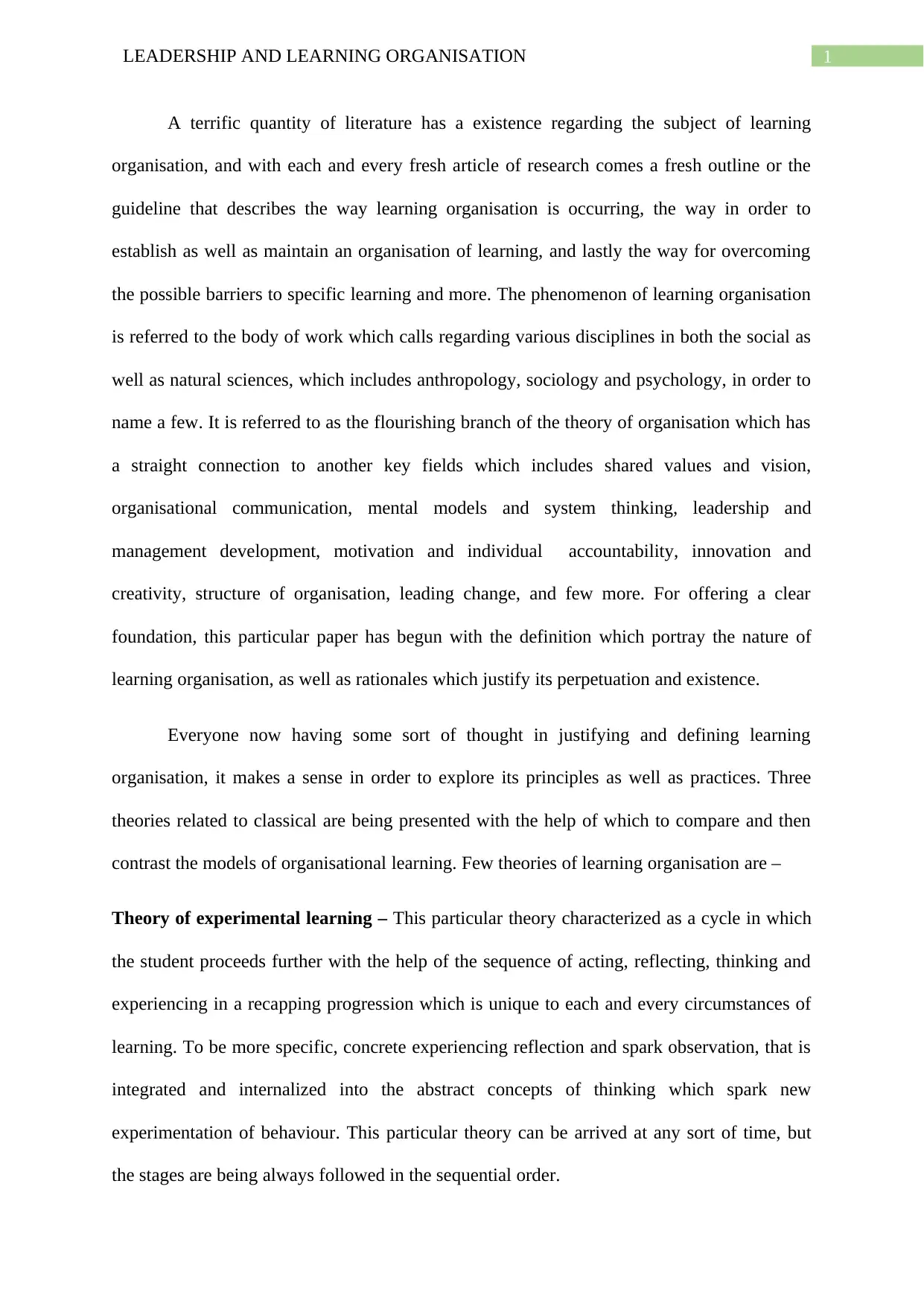
1LEADERSHIP AND LEARNING ORGANISATION
A terrific quantity of literature has a existence regarding the subject of learning
organisation, and with each and every fresh article of research comes a fresh outline or the
guideline that describes the way learning organisation is occurring, the way in order to
establish as well as maintain an organisation of learning, and lastly the way for overcoming
the possible barriers to specific learning and more. The phenomenon of learning organisation
is referred to the body of work which calls regarding various disciplines in both the social as
well as natural sciences, which includes anthropology, sociology and psychology, in order to
name a few. It is referred to as the flourishing branch of the theory of organisation which has
a straight connection to another key fields which includes shared values and vision,
organisational communication, mental models and system thinking, leadership and
management development, motivation and individual accountability, innovation and
creativity, structure of organisation, leading change, and few more. For offering a clear
foundation, this particular paper has begun with the definition which portray the nature of
learning organisation, as well as rationales which justify its perpetuation and existence.
Everyone now having some sort of thought in justifying and defining learning
organisation, it makes a sense in order to explore its principles as well as practices. Three
theories related to classical are being presented with the help of which to compare and then
contrast the models of organisational learning. Few theories of learning organisation are –
Theory of experimental learning – This particular theory characterized as a cycle in which
the student proceeds further with the help of the sequence of acting, reflecting, thinking and
experiencing in a recapping progression which is unique to each and every circumstances of
learning. To be more specific, concrete experiencing reflection and spark observation, that is
integrated and internalized into the abstract concepts of thinking which spark new
experimentation of behaviour. This particular theory can be arrived at any sort of time, but
the stages are being always followed in the sequential order.
A terrific quantity of literature has a existence regarding the subject of learning
organisation, and with each and every fresh article of research comes a fresh outline or the
guideline that describes the way learning organisation is occurring, the way in order to
establish as well as maintain an organisation of learning, and lastly the way for overcoming
the possible barriers to specific learning and more. The phenomenon of learning organisation
is referred to the body of work which calls regarding various disciplines in both the social as
well as natural sciences, which includes anthropology, sociology and psychology, in order to
name a few. It is referred to as the flourishing branch of the theory of organisation which has
a straight connection to another key fields which includes shared values and vision,
organisational communication, mental models and system thinking, leadership and
management development, motivation and individual accountability, innovation and
creativity, structure of organisation, leading change, and few more. For offering a clear
foundation, this particular paper has begun with the definition which portray the nature of
learning organisation, as well as rationales which justify its perpetuation and existence.
Everyone now having some sort of thought in justifying and defining learning
organisation, it makes a sense in order to explore its principles as well as practices. Three
theories related to classical are being presented with the help of which to compare and then
contrast the models of organisational learning. Few theories of learning organisation are –
Theory of experimental learning – This particular theory characterized as a cycle in which
the student proceeds further with the help of the sequence of acting, reflecting, thinking and
experiencing in a recapping progression which is unique to each and every circumstances of
learning. To be more specific, concrete experiencing reflection and spark observation, that is
integrated and internalized into the abstract concepts of thinking which spark new
experimentation of behaviour. This particular theory can be arrived at any sort of time, but
the stages are being always followed in the sequential order.
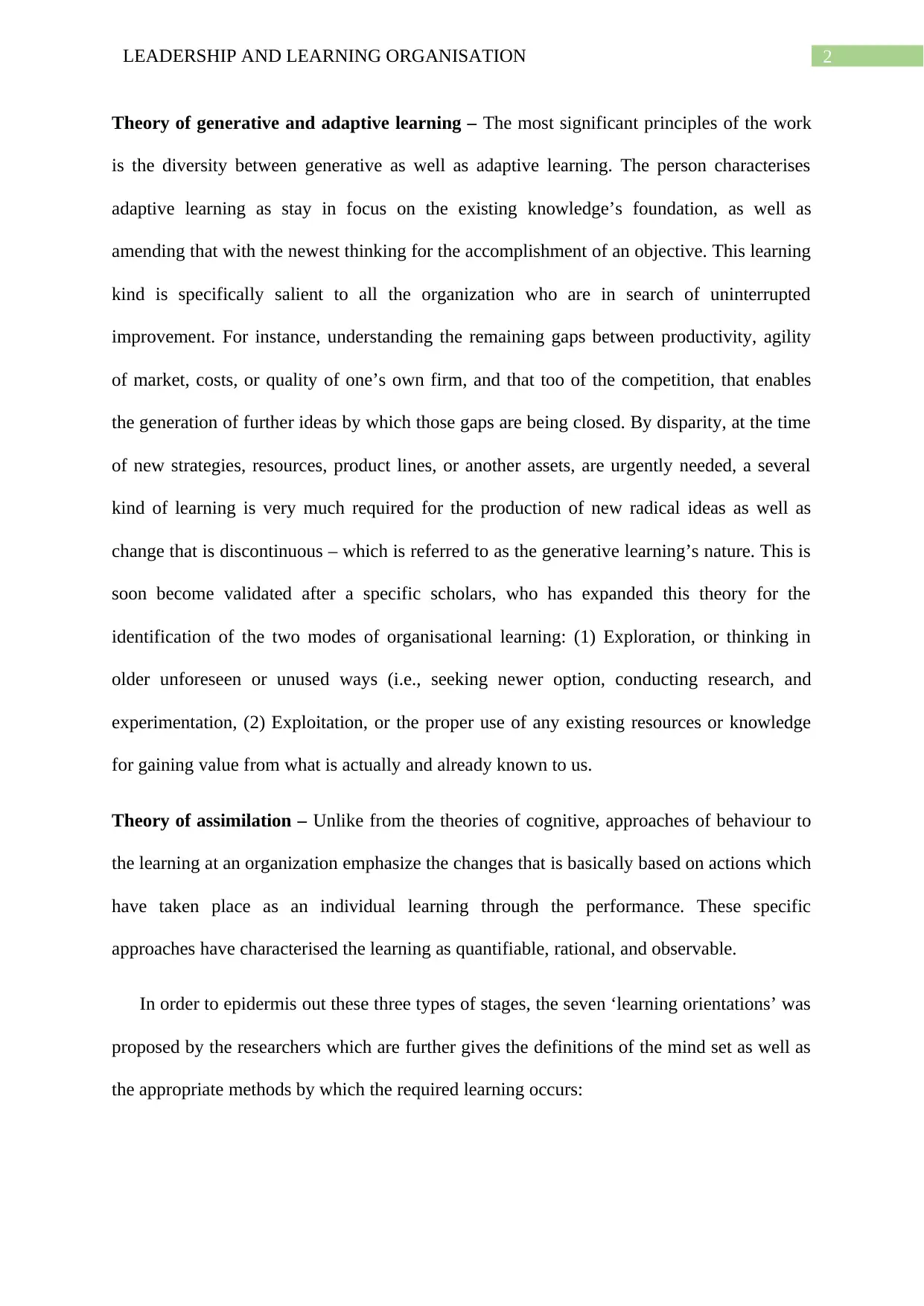
2LEADERSHIP AND LEARNING ORGANISATION
Theory of generative and adaptive learning – The most significant principles of the work
is the diversity between generative as well as adaptive learning. The person characterises
adaptive learning as stay in focus on the existing knowledge’s foundation, as well as
amending that with the newest thinking for the accomplishment of an objective. This learning
kind is specifically salient to all the organization who are in search of uninterrupted
improvement. For instance, understanding the remaining gaps between productivity, agility
of market, costs, or quality of one’s own firm, and that too of the competition, that enables
the generation of further ideas by which those gaps are being closed. By disparity, at the time
of new strategies, resources, product lines, or another assets, are urgently needed, a several
kind of learning is very much required for the production of new radical ideas as well as
change that is discontinuous – which is referred to as the generative learning’s nature. This is
soon become validated after a specific scholars, who has expanded this theory for the
identification of the two modes of organisational learning: (1) Exploration, or thinking in
older unforeseen or unused ways (i.e., seeking newer option, conducting research, and
experimentation, (2) Exploitation, or the proper use of any existing resources or knowledge
for gaining value from what is actually and already known to us.
Theory of assimilation – Unlike from the theories of cognitive, approaches of behaviour to
the learning at an organization emphasize the changes that is basically based on actions which
have taken place as an individual learning through the performance. These specific
approaches have characterised the learning as quantifiable, rational, and observable.
In order to epidermis out these three types of stages, the seven ‘learning orientations’ was
proposed by the researchers which are further gives the definitions of the mind set as well as
the appropriate methods by which the required learning occurs:
Theory of generative and adaptive learning – The most significant principles of the work
is the diversity between generative as well as adaptive learning. The person characterises
adaptive learning as stay in focus on the existing knowledge’s foundation, as well as
amending that with the newest thinking for the accomplishment of an objective. This learning
kind is specifically salient to all the organization who are in search of uninterrupted
improvement. For instance, understanding the remaining gaps between productivity, agility
of market, costs, or quality of one’s own firm, and that too of the competition, that enables
the generation of further ideas by which those gaps are being closed. By disparity, at the time
of new strategies, resources, product lines, or another assets, are urgently needed, a several
kind of learning is very much required for the production of new radical ideas as well as
change that is discontinuous – which is referred to as the generative learning’s nature. This is
soon become validated after a specific scholars, who has expanded this theory for the
identification of the two modes of organisational learning: (1) Exploration, or thinking in
older unforeseen or unused ways (i.e., seeking newer option, conducting research, and
experimentation, (2) Exploitation, or the proper use of any existing resources or knowledge
for gaining value from what is actually and already known to us.
Theory of assimilation – Unlike from the theories of cognitive, approaches of behaviour to
the learning at an organization emphasize the changes that is basically based on actions which
have taken place as an individual learning through the performance. These specific
approaches have characterised the learning as quantifiable, rational, and observable.
In order to epidermis out these three types of stages, the seven ‘learning orientations’ was
proposed by the researchers which are further gives the definitions of the mind set as well as
the appropriate methods by which the required learning occurs:
⊘ This is a preview!⊘
Do you want full access?
Subscribe today to unlock all pages.

Trusted by 1+ million students worldwide
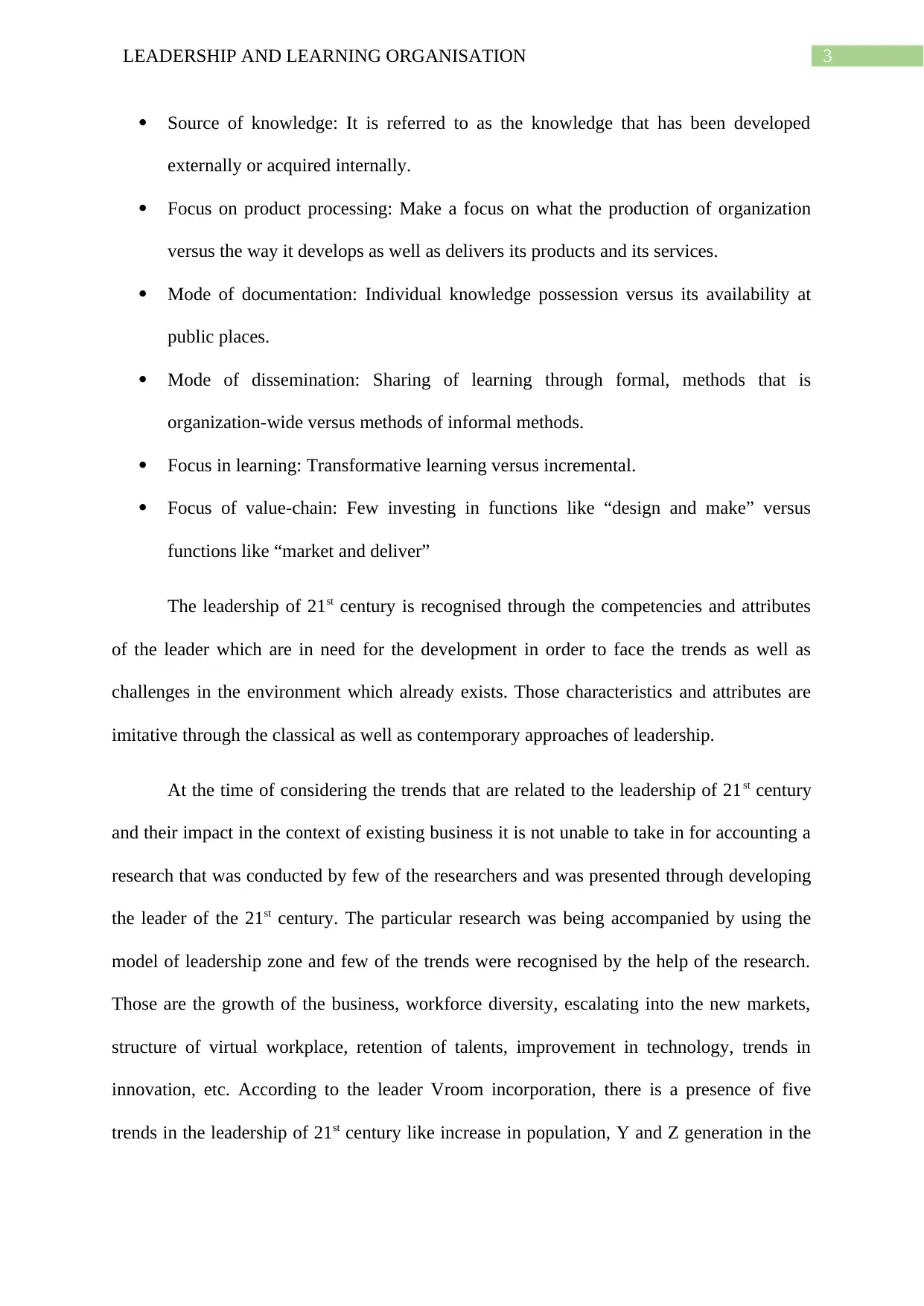
3LEADERSHIP AND LEARNING ORGANISATION
Source of knowledge: It is referred to as the knowledge that has been developed
externally or acquired internally.
Focus on product processing: Make a focus on what the production of organization
versus the way it develops as well as delivers its products and its services.
Mode of documentation: Individual knowledge possession versus its availability at
public places.
Mode of dissemination: Sharing of learning through formal, methods that is
organization-wide versus methods of informal methods.
Focus in learning: Transformative learning versus incremental.
Focus of value-chain: Few investing in functions like “design and make” versus
functions like “market and deliver”
The leadership of 21st century is recognised through the competencies and attributes
of the leader which are in need for the development in order to face the trends as well as
challenges in the environment which already exists. Those characteristics and attributes are
imitative through the classical as well as contemporary approaches of leadership.
At the time of considering the trends that are related to the leadership of 21st century
and their impact in the context of existing business it is not unable to take in for accounting a
research that was conducted by few of the researchers and was presented through developing
the leader of the 21st century. The particular research was being accompanied by using the
model of leadership zone and few of the trends were recognised by the help of the research.
Those are the growth of the business, workforce diversity, escalating into the new markets,
structure of virtual workplace, retention of talents, improvement in technology, trends in
innovation, etc. According to the leader Vroom incorporation, there is a presence of five
trends in the leadership of 21st century like increase in population, Y and Z generation in the
Source of knowledge: It is referred to as the knowledge that has been developed
externally or acquired internally.
Focus on product processing: Make a focus on what the production of organization
versus the way it develops as well as delivers its products and its services.
Mode of documentation: Individual knowledge possession versus its availability at
public places.
Mode of dissemination: Sharing of learning through formal, methods that is
organization-wide versus methods of informal methods.
Focus in learning: Transformative learning versus incremental.
Focus of value-chain: Few investing in functions like “design and make” versus
functions like “market and deliver”
The leadership of 21st century is recognised through the competencies and attributes
of the leader which are in need for the development in order to face the trends as well as
challenges in the environment which already exists. Those characteristics and attributes are
imitative through the classical as well as contemporary approaches of leadership.
At the time of considering the trends that are related to the leadership of 21st century
and their impact in the context of existing business it is not unable to take in for accounting a
research that was conducted by few of the researchers and was presented through developing
the leader of the 21st century. The particular research was being accompanied by using the
model of leadership zone and few of the trends were recognised by the help of the research.
Those are the growth of the business, workforce diversity, escalating into the new markets,
structure of virtual workplace, retention of talents, improvement in technology, trends in
innovation, etc. According to the leader Vroom incorporation, there is a presence of five
trends in the leadership of 21st century like increase in population, Y and Z generation in the
Paraphrase This Document
Need a fresh take? Get an instant paraphrase of this document with our AI Paraphraser
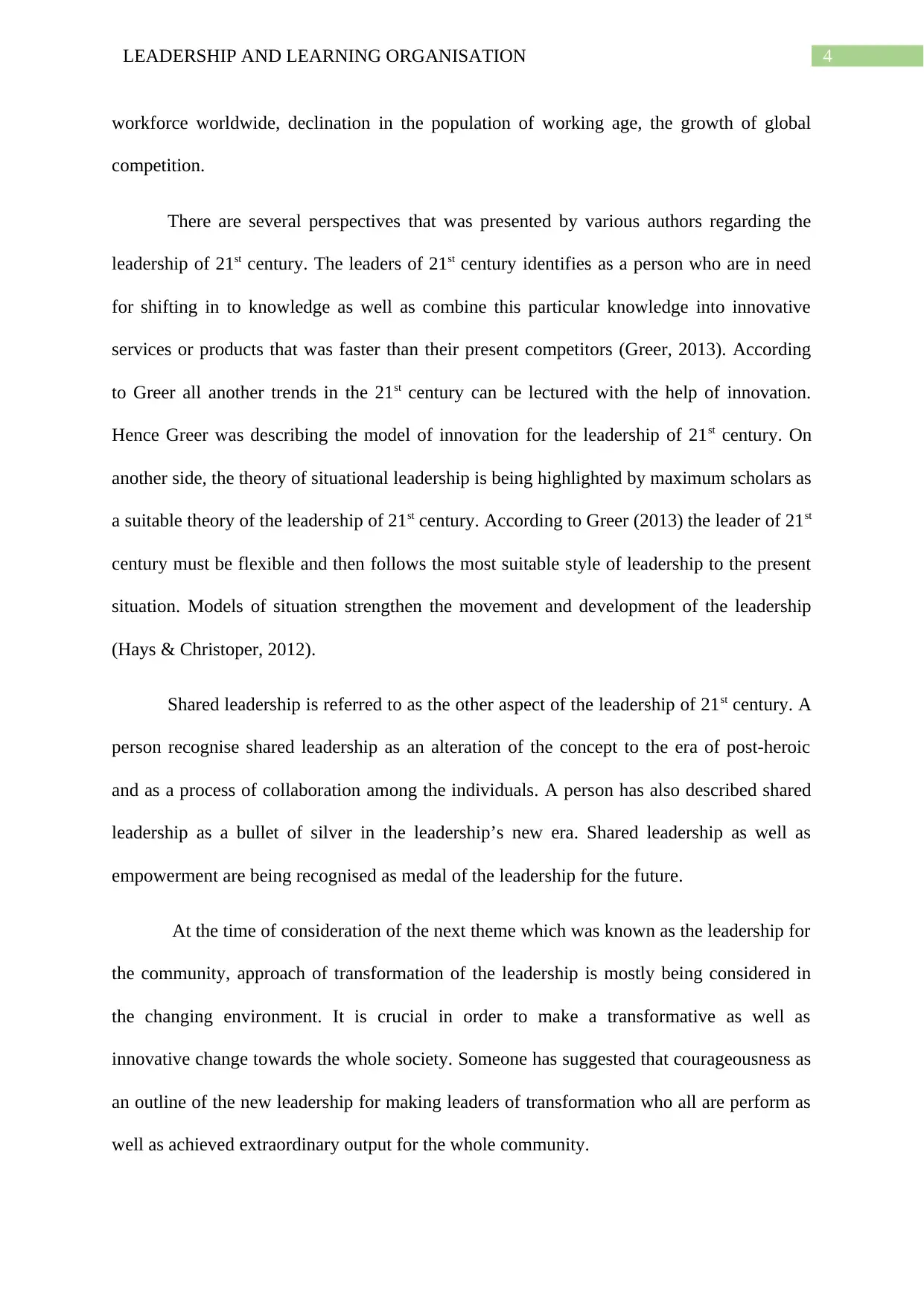
4LEADERSHIP AND LEARNING ORGANISATION
workforce worldwide, declination in the population of working age, the growth of global
competition.
There are several perspectives that was presented by various authors regarding the
leadership of 21st century. The leaders of 21st century identifies as a person who are in need
for shifting in to knowledge as well as combine this particular knowledge into innovative
services or products that was faster than their present competitors (Greer, 2013). According
to Greer all another trends in the 21st century can be lectured with the help of innovation.
Hence Greer was describing the model of innovation for the leadership of 21st century. On
another side, the theory of situational leadership is being highlighted by maximum scholars as
a suitable theory of the leadership of 21st century. According to Greer (2013) the leader of 21st
century must be flexible and then follows the most suitable style of leadership to the present
situation. Models of situation strengthen the movement and development of the leadership
(Hays & Christoper, 2012).
Shared leadership is referred to as the other aspect of the leadership of 21st century. A
person recognise shared leadership as an alteration of the concept to the era of post-heroic
and as a process of collaboration among the individuals. A person has also described shared
leadership as a bullet of silver in the leadership’s new era. Shared leadership as well as
empowerment are being recognised as medal of the leadership for the future.
At the time of consideration of the next theme which was known as the leadership for
the community, approach of transformation of the leadership is mostly being considered in
the changing environment. It is crucial in order to make a transformative as well as
innovative change towards the whole society. Someone has suggested that courageousness as
an outline of the new leadership for making leaders of transformation who all are perform as
well as achieved extraordinary output for the whole community.
workforce worldwide, declination in the population of working age, the growth of global
competition.
There are several perspectives that was presented by various authors regarding the
leadership of 21st century. The leaders of 21st century identifies as a person who are in need
for shifting in to knowledge as well as combine this particular knowledge into innovative
services or products that was faster than their present competitors (Greer, 2013). According
to Greer all another trends in the 21st century can be lectured with the help of innovation.
Hence Greer was describing the model of innovation for the leadership of 21st century. On
another side, the theory of situational leadership is being highlighted by maximum scholars as
a suitable theory of the leadership of 21st century. According to Greer (2013) the leader of 21st
century must be flexible and then follows the most suitable style of leadership to the present
situation. Models of situation strengthen the movement and development of the leadership
(Hays & Christoper, 2012).
Shared leadership is referred to as the other aspect of the leadership of 21st century. A
person recognise shared leadership as an alteration of the concept to the era of post-heroic
and as a process of collaboration among the individuals. A person has also described shared
leadership as a bullet of silver in the leadership’s new era. Shared leadership as well as
empowerment are being recognised as medal of the leadership for the future.
At the time of consideration of the next theme which was known as the leadership for
the community, approach of transformation of the leadership is mostly being considered in
the changing environment. It is crucial in order to make a transformative as well as
innovative change towards the whole society. Someone has suggested that courageousness as
an outline of the new leadership for making leaders of transformation who all are perform as
well as achieved extraordinary output for the whole community.
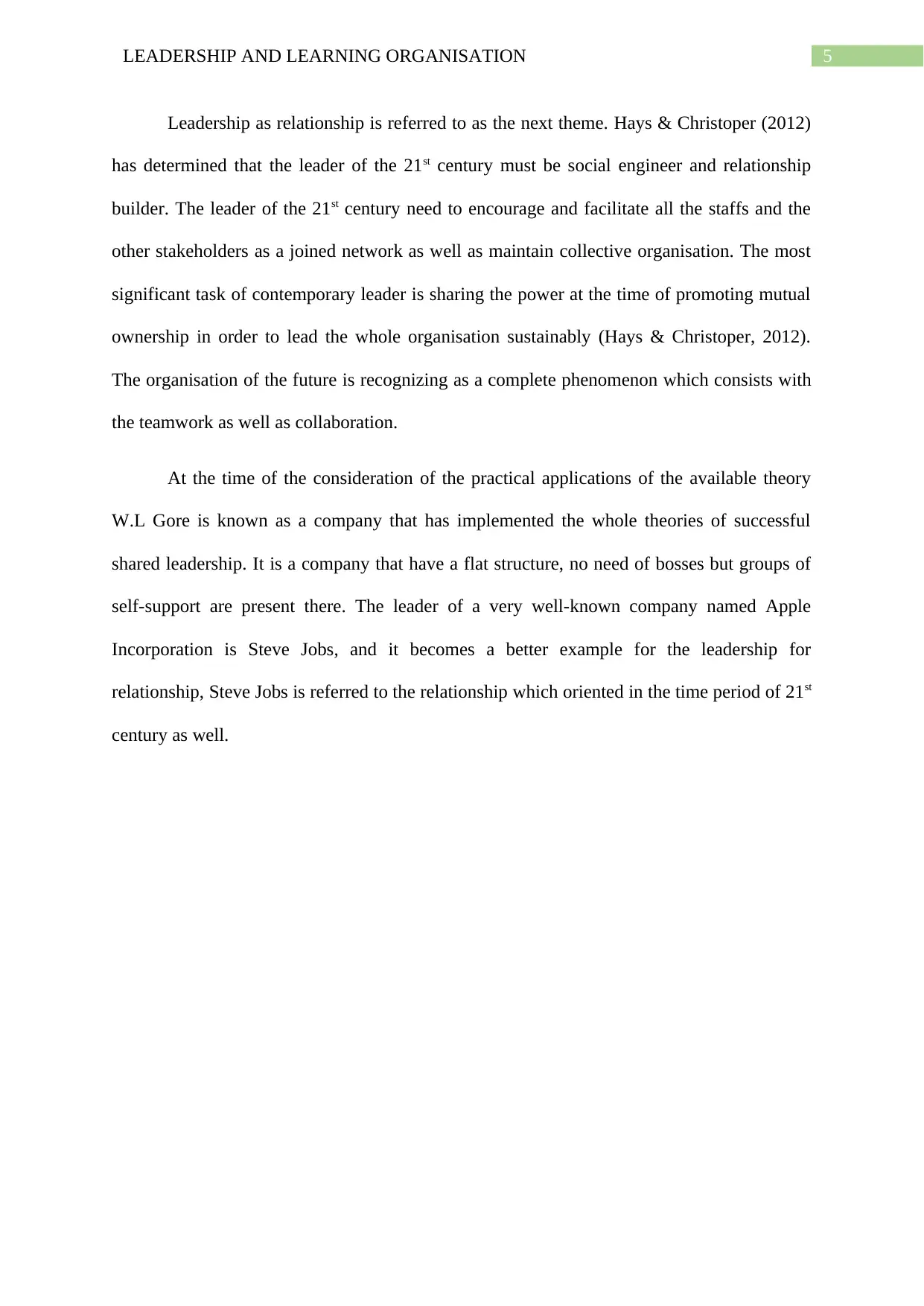
5LEADERSHIP AND LEARNING ORGANISATION
Leadership as relationship is referred to as the next theme. Hays & Christoper (2012)
has determined that the leader of the 21st century must be social engineer and relationship
builder. The leader of the 21st century need to encourage and facilitate all the staffs and the
other stakeholders as a joined network as well as maintain collective organisation. The most
significant task of contemporary leader is sharing the power at the time of promoting mutual
ownership in order to lead the whole organisation sustainably (Hays & Christoper, 2012).
The organisation of the future is recognizing as a complete phenomenon which consists with
the teamwork as well as collaboration.
At the time of the consideration of the practical applications of the available theory
W.L Gore is known as a company that has implemented the whole theories of successful
shared leadership. It is a company that have a flat structure, no need of bosses but groups of
self-support are present there. The leader of a very well-known company named Apple
Incorporation is Steve Jobs, and it becomes a better example for the leadership for
relationship, Steve Jobs is referred to the relationship which oriented in the time period of 21st
century as well.
Leadership as relationship is referred to as the next theme. Hays & Christoper (2012)
has determined that the leader of the 21st century must be social engineer and relationship
builder. The leader of the 21st century need to encourage and facilitate all the staffs and the
other stakeholders as a joined network as well as maintain collective organisation. The most
significant task of contemporary leader is sharing the power at the time of promoting mutual
ownership in order to lead the whole organisation sustainably (Hays & Christoper, 2012).
The organisation of the future is recognizing as a complete phenomenon which consists with
the teamwork as well as collaboration.
At the time of the consideration of the practical applications of the available theory
W.L Gore is known as a company that has implemented the whole theories of successful
shared leadership. It is a company that have a flat structure, no need of bosses but groups of
self-support are present there. The leader of a very well-known company named Apple
Incorporation is Steve Jobs, and it becomes a better example for the leadership for
relationship, Steve Jobs is referred to the relationship which oriented in the time period of 21st
century as well.
⊘ This is a preview!⊘
Do you want full access?
Subscribe today to unlock all pages.

Trusted by 1+ million students worldwide
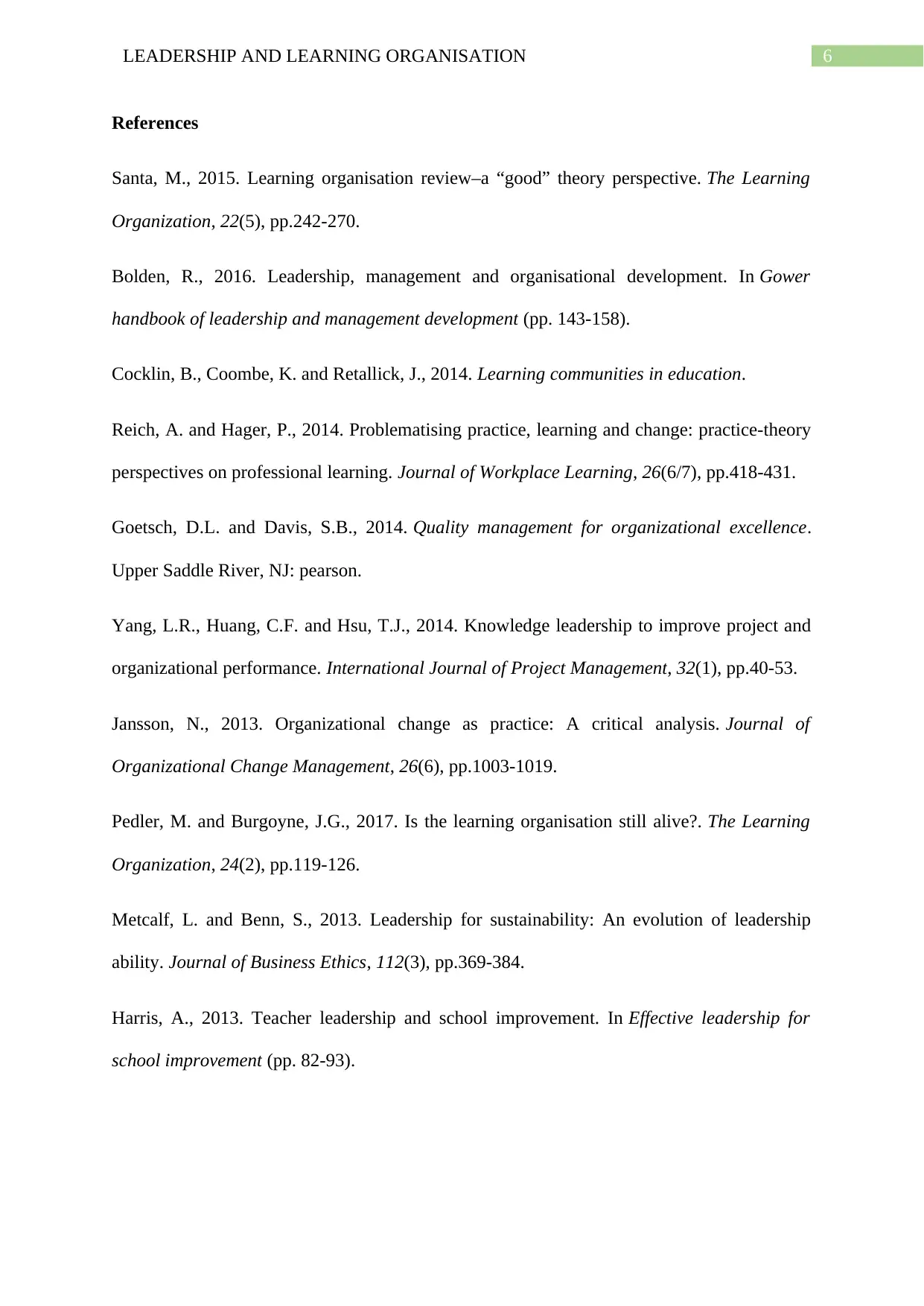
6LEADERSHIP AND LEARNING ORGANISATION
References
Santa, M., 2015. Learning organisation review–a “good” theory perspective. The Learning
Organization, 22(5), pp.242-270.
Bolden, R., 2016. Leadership, management and organisational development. In Gower
handbook of leadership and management development (pp. 143-158).
Cocklin, B., Coombe, K. and Retallick, J., 2014. Learning communities in education.
Reich, A. and Hager, P., 2014. Problematising practice, learning and change: practice-theory
perspectives on professional learning. Journal of Workplace Learning, 26(6/7), pp.418-431.
Goetsch, D.L. and Davis, S.B., 2014. Quality management for organizational excellence.
Upper Saddle River, NJ: pearson.
Yang, L.R., Huang, C.F. and Hsu, T.J., 2014. Knowledge leadership to improve project and
organizational performance. International Journal of Project Management, 32(1), pp.40-53.
Jansson, N., 2013. Organizational change as practice: A critical analysis. Journal of
Organizational Change Management, 26(6), pp.1003-1019.
Pedler, M. and Burgoyne, J.G., 2017. Is the learning organisation still alive?. The Learning
Organization, 24(2), pp.119-126.
Metcalf, L. and Benn, S., 2013. Leadership for sustainability: An evolution of leadership
ability. Journal of Business Ethics, 112(3), pp.369-384.
Harris, A., 2013. Teacher leadership and school improvement. In Effective leadership for
school improvement (pp. 82-93).
References
Santa, M., 2015. Learning organisation review–a “good” theory perspective. The Learning
Organization, 22(5), pp.242-270.
Bolden, R., 2016. Leadership, management and organisational development. In Gower
handbook of leadership and management development (pp. 143-158).
Cocklin, B., Coombe, K. and Retallick, J., 2014. Learning communities in education.
Reich, A. and Hager, P., 2014. Problematising practice, learning and change: practice-theory
perspectives on professional learning. Journal of Workplace Learning, 26(6/7), pp.418-431.
Goetsch, D.L. and Davis, S.B., 2014. Quality management for organizational excellence.
Upper Saddle River, NJ: pearson.
Yang, L.R., Huang, C.F. and Hsu, T.J., 2014. Knowledge leadership to improve project and
organizational performance. International Journal of Project Management, 32(1), pp.40-53.
Jansson, N., 2013. Organizational change as practice: A critical analysis. Journal of
Organizational Change Management, 26(6), pp.1003-1019.
Pedler, M. and Burgoyne, J.G., 2017. Is the learning organisation still alive?. The Learning
Organization, 24(2), pp.119-126.
Metcalf, L. and Benn, S., 2013. Leadership for sustainability: An evolution of leadership
ability. Journal of Business Ethics, 112(3), pp.369-384.
Harris, A., 2013. Teacher leadership and school improvement. In Effective leadership for
school improvement (pp. 82-93).
1 out of 7
Related Documents
Your All-in-One AI-Powered Toolkit for Academic Success.
+13062052269
info@desklib.com
Available 24*7 on WhatsApp / Email
![[object Object]](/_next/static/media/star-bottom.7253800d.svg)
Unlock your academic potential
Copyright © 2020–2025 A2Z Services. All Rights Reserved. Developed and managed by ZUCOL.





